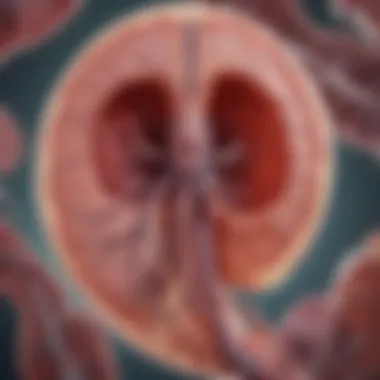FSGS and Proteinuria: Implications for Kidney Health


Intro
Focal Segmental Glomerulosclerosis (FSGS) is a critical area of research in nephrology, central to understanding a range of kidney health issues. This article aims to provide an in-depth exploration of the relationship between FSGS and proteinuria. By unraveling the complexities of this connection, it aspires to illuminate recent advances in treatment, diagnostic measures, and ongoing research.
In this comprehensive examination, the implications of these conditions on kidney health will be scrutinized. This exploration not only serves to synthesize existing knowledge but also highlights the need for continued research in this vital area of nephrological study.
Research Background
Overview of the Scientific Problem Addressed
FSGS is characterized by scarring in the kidney glomeruli, leading to proteinuria, which is the presence of excess protein in urine. This condition poses serious risks, including progressive kidney damage and potential end-stage renal failure. Understanding the mechanisms by which FSGS and proteinuria interact is essential for developing effective treatment strategies.
Historical Context and Previous Studies
Historically, FSGS was not well understood. Initial studies focused on its pathological features and clinical outcomes without delving deeply into the underlying pathophysiology. Over the years, research has evolved. Insights from genetic studies and advancements in imaging techniques have radically changed the understanding of FSGS, its etiology, and its clinical relevance. Notable studies have linked FSGS to various factors, including viral infections, obesity, and genetic predisposition.
Researchers have observed a strong correlation between proteinuria levels and decline in kidney function, signaling proteinuria's role as a vital clinical marker in assessing kidney health. Advances in immunosuppressive therapies also offer hope for patients suffering from FSGS, marking a shift towards more targeted treatment approaches.
Findings and Discussion
Key Results of the Research
Recent research reveals that FSGS can arise from multiple causes, including minimal change disease and secondary factors like diabetes mellitus. Proteinuria serves as a key indicator of disease progression, suggesting that monitoring protein levels in urine can guide clinical decisions. Studies demonstrate that early intervention in cases with high proteinuria can stabilize kidney function.
Interpretation of the Findings
The relationship between FSGS and proteinuria underscores the complexity of kidney disease. While FSGS may initiate damage, proteinuria amplifies the issue by reflecting ongoing pathological processes. Thus, addressing underlying causes of FSGS while closely monitoring proteinuria could lead to better clinical outcomes. As treatments continue to advance, understanding this interplay becomes increasingly crucial in nephrology.
"Proteinuria is not merely a symptom; it reflects the underlying dynamics of kidney injury and recovery."
Understanding FSGS
Focal Segmental Glomerulosclerosis, or FSGS, is a significant focus within nephrology, commanding attention for its profound implications on kidney health. This condition impairs kidney functionality, often leading to end-stage renal disease if not adequately addressed. Understanding FSGS is essential, as it provides insights into the kidneys' function and the potential pathways for disease progression. Moreover, recognizing the characteristics and underlying mechanisms of FSGS lays the groundwork for developing effective interventions and management strategies.
Definition and Characteristics
FSGS refers to a group of kidney disorders characterized by scarring (sclerosis) of the glomeruli, which are crucial for filtering blood. It specifically affects some segments of the glomeruli, leading to a decrease in filtration efficiency. The diagnosis of FSGS can occur at any age, although it commonly presents in adults. A key trait of FSGS is proteinuria, the presence of excess protein in the urine, which serves as a hallmark of glomerular injury.
Key features of FSGS include:
- Variable presentations: FSGS can manifest differently among patients, from asymptomatic cases to those with significant symptoms such as swelling and fatigue.
- Predictable progression: Without proper management, the disease can lead to chronic kidney disease.
Etiology and Risk Factors
The etiology of FSGS is multifactorial, involving genetic and environmental influences. Several risk factors have been identified that contribute to the development of FSGS:
- Genetic predisposition: Certain genetic mutations have been linked to primary FSGS.
- Obesity: Excess body weight is a known contributor to the progression of kidney diseases, including FSGS.
- Diabetes and hypertension: These chronic conditions can lead to kidney damage and are significant risk factors for FSGS.
- Infections and toxins: Viral infections and exposure to nephrotoxic substances may precipitate or exacerbate FSGS.
Identifying these risk factors allows for timely interventions that can potentially slow the disease's progression or mitigate its impacts.
Pathophysiology of FSGS
The pathophysiology of FSGS involves complex immune responses and changes in the physiological state of the kidney. The damage to the podocytes, the cells that form the glomerular filtration barrier, is central to the disease process. These cells lose integrity, leading to increased permeability and resulting in protein leakage into the urine. Consequently, this proteinuria can contribute to further kidney damage, creating a cycle of injury and dysfunction.
Important aspects of the pathophysiology include:


- Inflammatory processes: Inflammation plays a central role in the progression of FSGS, with cytokines acting to amplify podocyte injury.
- Hemodynamic changes: Altered blood flow and pressure in the glomeruli exacerbate the damages, leading to scarring.
Overall, understanding the pathophysiological mechanisms of FSGS is pivotal for developing targeted therapeutic strategies that could effectively address the underlying causes and improve kidney health.
Proteinuria in FSGS
Proteinuria serves as a key indicator of kidney health, particularly in the context of Focal Segmental Glomerulosclerosis (FSGS). This section uncovers the pivotal role of proteinuria in FSGS, highlighting its implications for diagnosis, monitoring, and treatment. Understanding proteinuria is critical for forming a comprehensive view of kidney function and susceptibility to various diseases.
Defining Proteinuria
Proteinuria refers to the presence of excess protein in the urine. This condition reflects a disruption in the kidney's filtration system, specifically the glomeruli. Glomeruli are tiny filtering units in the kidneys that play a crucial role in maintaining protein levels in the bloodstream. When these filters become damaged, as in the case of FSGS, proteins such as albumin leak into the urine. Measurement of proteinuria is often done through urine tests, including 24-hour urine collection or spot urine tests. Understanding the exact definition of proteinuria is essential in assessing kidney health.
Mechanisms of Proteinuria in FSGS
The mechanisms leading to proteinuria in FSGS are complex but can be condensed into several key processes:
- Damage to Glomerular Capillaries: FSGS causes damage to the glomeruli, which compromises their ability to filter blood effectively. Large molecules like proteins are not retained, leading to their presence in urine.
- Podocyte Dysfunction: Podocytes are specialized cells that wrap around the glomerular capillaries. In FSGS, these cells lose their structural integrity and function, resulting in increased protein leakage due to defects in the filtration barrier.
- Inflammatory Processes: FSGS often involves inflammatory pathways that further exacerbate damage to kidney tissues. This inflammation alters the glomerular architecture, often worsening proteinuria.
These mechanisms illustrate why proteinuria is not just a symptom but also a fundamental part of the underlying pathophysiology of FSGS. Understanding these pathways is crucial for developing appropriate treatments.
Clinical Significance of Proteinuria
The clinical implications of proteinuria in FSGS are profound. Its presence is not merely a marker; it signifies several important aspects:
- Indicator of Disease Progression: Elevated levels of proteinuria can indicate a worsening of kidney function and help predict outcomes for patients with FSGS.
- Guide to Treatment Strategies: Monitoring protein levels can inform the efficacy of therapeutic interventions, allowing clinicians to adjust treatments as necessary.
- Prognostic Value: Proteinuria has been correlated with long-term kidney health outcomes. High levels of proteinuria may associate with a higher risk of progression to end-stage renal disease.
Understanding proteinuria is integral to managing FSGS. Regular monitoring can lead to timely interventions and improved patient outcomes.
In summary, proteinuria is a significant clinical marker in the context of FSGS. Its definition, mechanisms, and clinical importance form the cornerstone of nephrological assessments. This understanding can lead to enhanced management strategies and better prognoses for individuals dealing with this complex kidney condition.
Diagnosis of FSGS and Proteinuria
Diagnosing Focal Segmental Glomerulosclerosis (FSGS) is crucial for effective management of kidney health. FSGS manifests through increasing proteinuria and can ultimately lead to progressive kidney dysfunction. Early diagnosis enables timely intervention, which can slow disease progression and improve patient outcomes. In this section, we will discuss the vital elements of diagnosis, which include diagnostic criteria, laboratory tests, and the role of kidney biopsy.
Diagnostic Criteria
The diagnostic criteria for FSGS are essential for distinguishing it from other forms of kidney disease. Clinicians consider several factors:
- Clinical Symptoms: Patients might present with nephrotic syndrome, characterized by massive proteinuria, edema, and hypoalbuminemia.
- Urinalysis: A 24-hour urine collection often shows elevated protein levels, typically exceeding 3.5 grams. Dipstick tests are also useful for quick assessments.
- Kidney Function: Measurement of serum creatinine and glomerular filtration rate (GFR) provides insights into kidney function status.
These criteria guide practitioners in recognizing FSGS and will inform subsequent diagnostic procedures.
Laboratory Tests and Assessments
Laboratory tests play a critical role in confirming FSGS and evaluating its severity. Key tests include:
- Urinalysis: Identification of protein in urine is the primary indicator. The presence of hematuria or casts may also suggest glomerular injury.
- Serum Albumin Levels: Low serum albumin levels indicate significant protein loss and confirm nephrotic syndrome.
- Kidney Function Tests: Monitoring creatinine levels is important, as elevated levels indicate impaired kidney function.
- Immunological Tests: Tests for autoantibodies can help rule out secondary causes of proteinuria, such as lupus or diabetic nephropathy.
These assessments provide a comprehensive view of the patient's condition, allowing for a tailored treatment approach.
Role of Kidney Biopsy
The kidney biopsy is often considered the gold standard for diagnosing FSGS. This procedure involves:
- Obtaining Tissue Samples: Biopsies extract small tissues from the kidney, which are then examined microscopically for characteristic changes associated with FSGS.
- Identifying Subtypes: A biopsy can help distinguish between primary and secondary FSGS, crucial for treatment planning. Primary FSGS often reflects genetic or idiopathic origins, while secondary FSGS can result from infections, drugs, or other conditions.
- Assessing Damage: Pathological findings guide clinicians in understanding the extent of glomerular damage and renal scarring.


A kidney biopsy is not always necessary for diagnosis, especially if the clinical picture is clear. However, it provides valuable information for guiding therapy in complicated cases.
Advancements in treatment
The treatment landscape for Focal Segmental Glomerulosclerosis (FSGS) has evolved significantly in recent years. Understanding these advancements is crucial for healthcare professionals, researchers, and students in nephrology. The development of new medications and therapeutic strategies directly impacts patient outcomes. Innovative treatment options can lead to improved kidney function and quality of life for patients suffering from FSGS and its associated proteinuria.
Conventional Treatment Options
Conventional treatment options for FSGS typically include the use of corticosteroids like prednisone and immunosuppressive therapies. These drugs aim to reduce inflammation in the kidneys and manage symptoms like proteinuria. A standard first-line approach consists of corticosteroids given at high doses initially, followed by a tapering strategy. The use of immunosuppressants like cyclophosphamide or mycophenolate mofetil may also be considered in patients resistant to corticosteroids.
Key Considerations:
- Monitoring is essential during treatment. Regular kidney function tests and urinalysis should be conducted to assess therapy effectiveness and adjust dosages as necessary.
- Side effects from long-term corticosteroid use can include hypertension, diabetes, and opportunistic infections. It is important to weigh these risks against the benefits of immunosuppressive treatments.
These conventional methods continue to play a significant role in the management of FSGS, especially in populations identified to respond well to steroid therapy.
Emerging Therapeutic Approaches
The area of FSGS treatment is witnessing several promising emerging therapies. New medications like angiotensin II receptor blockers (ARBs) and angiotensin-converting enzyme (ACE) inhibitors are gaining attention. They not only control blood pressure but also reduce proteinuria, showcasing the dual benefit of protecting kidney function while managing symptoms.
Another emerging treatment avenue is the exploration of biologic agents. These drugs specifically target immune pathways involved in the inflammatory process of FSGS. They offer a more tailored approach to treatment. Clinical trials are currently investigating safety and effectiveness, with various agents such as rituximab showing promise.
"The future of FSGS treatment lies in precision medicine, utilizing therapies tailored to the individual's disease characteristics."
Management of Proteinuria
Managing proteinuria is a significant aspect of treatment in patients with FSGS. High levels of protein in urine can be indicative of worsening kidney health. Effective management strategies should focus on both the underlying disease process and the associated proteinuria.
- Lifestyle modifications are often recommended. Patients should be encouraged to adopt a low-sodium diet, engage in regular physical activity, and maintain a healthy weight. These changes can help lower blood pressure and further protect kidney function.
- Pharmacologic interventions can also play a critical role. Beyond ARBs and ACE inhibitors mentioned earlier, studies are evaluating other agents aimed explicitly at reducing proteinuria. These could offer new pathways to divert or mitigate protein loss.
- Regular follow-ups are essential to track the patient’s progress and adapt management as needed. Continuous monitoring provides data that can guide further interventions to improve outcomes and quality of life.
Through a better understanding of treatment advancements for FSGS, particularly regarding established and new therapeutic strategies, healthcare professionals can significantly improve management plans tailored to the unique needs of each patient.
Prognosis and Outcomes
Understanding the prognosis and outcomes related to Focal Segmental Glomerulosclerosis (FSGS) and proteinuria is critical for both patients and healthcare professionals. The long-term perspective on kidney health can significantly inform treatment strategies and patient management.
Long-term Outcomes in FSGS
Long-term outcomes in FSGS can vary widely among individuals. Prognosis often depends on the underlying cause of FSGS, the extent of kidney damage, and how promptly treatment is initiated. In some cases, patients may maintain stable kidney function, while others may progress to end-stage renal disease (ESRD).
Key factors influencing long-term outcomes include:
- Histological Patterns: Different patterns of FSGS observed during a kidney biopsy can indicate varying prognoses. For instance, patients with primary FSGS might respond better to treatments than those with secondary FSGS related to other conditions.
- Response to Treatment: A significant aspect of prognosis is how well a patient responds to initial treatment. Early intervention may lead to better overall kidney function preservation.
- Renal Function at Diagnosis: Patients presenting with significant renal impairment at diagnosis often have worse outcomes compared to those diagnosed earlier in the disease progression.
- Presence of Other Health Conditions: Comorbidities such as diabetes and hypertension can complicate the clinical picture, negatively affecting overall kidney health and heightening the risk of complications.
The need for regular monitoring of kidney function and protein levels in urine is essential. Data from studies suggest that a careful follow-up can help in better management, leading to more favorable long-term outcomes.
Impact of Proteinuria on Prognosis
Proteinuria is not just a symptom in FSGS; it serves as a significant prognostic marker. The presence and level of proteinuria can offer insights into the disease severity and potential outcomes.
- Degree of Proteinuria: Higher levels of protein in the urine are often associated with more severe kidney damage and a poorer prognosis. Persistent and high-grade proteinuria typically indicates more advanced disease.
- Duration of Proteinuria: Prolonged proteinuria may lead to progressive damage to the glomeruli, exacerbating kidney dysfunction and increasing the risk of renal failure.
- Variables Affecting Prognosis: Factors such as age, sex, and race, in combination with proteinuria levels, can impact disease trajectory, underscoring the urgency of personalized approaches to management.
Monitoring and management of proteinuria should be integral to the overall treatment plan for FSGS patients. For example, medications such as angiotensin-converting enzyme (ACE) inhibitors can help not only reduce blood pressure but also decrease proteinuria levels, improving long-term kidney health.


"In patients with FSGS, controlling proteinuria effectively can delay the progression of kidney disease and lead to improved outcomes."
Research Insights and Future Directions
The field of Focal Segmental Glomerulosclerosis (FSGS) research is critical for advancing our understanding of kidney health. This focus on FSGS provides insights into the disease mechanisms, which is essential for developing effective interventions. Research in this area is paramount, as it drives innovations in treatment and enhances patient care.
Current Research Trends in FSGS
A notable trend in current research on FSGS is the investigation of genetic factors associated with the disease. Several studies have indicated that mutations in specific genes contribute to the development of FSGS. This genetic insight paves the way for targeted therapies, improving treatment outcomes. Moreover, many researchers are exploring biomarkers beyond proteinuria to improve diagnostic accuracy and monitor disease progression.
New therapeutic agents are also under scrutiny. The influence of immunosuppressive drugs, while recognized, is being evaluated in novel contexts. Experts are studying the role of agents such as sirolimus and mycophenolate mofetil, analyzing their efficacy in different patient populations. Additionally, understanding the role of the microbiome in kidney disease is emerging as a fascinating area of inquiry.
Challenges in FSGS Research
Despite the progress, several challenges persist in FSGS research. One significant obstacle is the heterogeneity of the disease, which makes it difficult to establish uniform treatment protocols. Different subtypes of FSGS can present varied clinical manifestations, complicating diagnosis and management.
Access to high-quality biopsy samples is another hurdle, as acquiring samples from diverse populations can be logistically challenging. Furthermore, funding for large-scale studies often falls short, hindering comprehensive research efforts. The complexity of FSGS requires collaborative approaches across disciplines to overcome these obstacles.
Potential Areas for Future Research
Future research in FSGS should focus on multiple aspects to fill the existing gaps. One important avenue is the exploration of personalized medicine approaches. By understanding individual patient characteristics—such as genetic predisposition and environmental factors—treatment can be tailored for enhanced effectiveness.
Another area worth examining is the long-term impact of treatments on kidney function and quality of life. Researchers can develop longitudinal studies that monitor patients overextended periods, offering insights into the durability of therapeutic responses.
Finally, exploring the potential of emerging technologies—such as artificial intelligence and machine learning—could revolutionize the analysis and interpretation of FSGS data. These technologies might provide deeper insights into disease pathways, potentially leading to the discovery of novel therapeutic targets.
"Future directions in FSGS research not only seek to understand the disease better but also focus on improving outcomes through targeted and personalized approaches."
Ethical Considerations in Research and Treatment
The ethical considerations in research and treatment of Focal Segmental Glomerulosclerosis (FSGS) are vital for ensuring that patient welfare is prioritized. Ethical frameworks guide researchers and clinicians in their decisions to balance scientific advancement with the rights and well-being of individuals. In the context of FSGS and associated proteinuria, a complex interplay exists between innovation, patient safety, and informed consent.
Ethical Challenges in FSGS Management
In managing FSGS, various ethical challenges arise. The complexity of the disease means treatment options can be limited or experimental. For instance, patients may be offered new therapeutic approaches that are still in the investigational stages. This raises questions about the safety and effectiveness of such treatments. Patients may not always be fully aware of the potential risks and benefits due to the technical nature of the information. As such, ensuring that patients have a clear understanding of their treatment options is crucial.
Additionally, the long-term implications of FSGS necessitate careful consideration in decision-making. Clinicians must weigh the immediate benefits of treatment against possible future complications. Patients should never be treated as mere subjects in a study, but rather as active participants in a decision-making process that directly affects their health outcomes. It is essential to maintain transparency about uncertainties in treatment efficacy, fostering trust between patients and healthcare providers.
Informed Consent in Clinical Trials
Informed consent stands as a cornerstone of ethical research. It reflects respect for a patient's autonomy and the acknowledgment of their right to make decisions regarding their health. In the context of clinical trials for FSGS, obtaining informed consent involves several steps. Firstly, researchers must provide comprehensive information about the study purpose, duration, procedures, potential risks, and benefits. It is important that this information is communicated in a clear and understandable manner, avoiding technical jargon that could confuse participants.
Moreover, potential participants should be made aware they can withdraw from the study at any time without affecting their standard of care. This assurance can help alleviate anxieties regarding participation in research. Informed consent should not be a one-time event; it is an ongoing process where patients can ask questions and receive answers throughout the study.
Informed consent is not merely a formality; it is a vital element that governs the ethical conduct of clinical trials.
Achieving true informed consent demands diligence and sensitivity from researchers. Individuals should feel empowered to make decisions that they believe are in their best interest after fully understanding the implications of their involvement. The ethical management of consent and patient treatment in FSGS not only supports scientific progress but also upholds the dignity and rights of every participant.
Closure
The conclusion wraps up the discussion on Focal Segmental Glomerulosclerosis and its connection with proteinuria. Understanding this relationship is crucial for several reasons. Firstly, it encapsulates the key findings throughout the article, serving as a summation of critical insights related to diagnosis, treatment, and prognosis. Secondly, it reinforces the importance of research in nephrology, particularly focusing on FSGS, which remains a perplexing area for many healthcare professionals.
From the information presented, one can see that the implications of proteinuria as a marker of kidney health cannot be overstated. It holds significant value in clinical practice, enabling clinicians to monitor disease progression and response to therapy. This specificity could ultimately lead to personalized treatment strategies, helping improve patient outcomes. Thus, concluding sections play a vital role in reiterating the necessity of ongoing research and clinical awareness in this field.
Summary of Key Findings
The article has covered various aspects of FSGS and proteinuria, emphasizing their interconnected nature in kidney health. Here are the key takeaways:
- Definition and Characteristics of FSGS: Understanding what FSGS entails provides a solid foundation for recognizing its implications in kidney disease.
- Etiology and Risk Factors: Knowledge of the underlying causes of FSGS informs clinical practice and highlights populations at risk.
- Pathophysiology of FSGS: Grasping the biological processes involved is essential for developing effective treatments.
- Clinical Significance of Proteinuria: Proteinuria serves not only as a diagnostic tool but also as a prognostic indicator in patients with FSGS.
- Advancements in Treatment: Emerging therapies show promise in managing FSGS, underscoring the need for continued research.
- Research Insights and Future Directions: This emphasizes the ongoing efforts to better understand FSGS and explore new therapeutic avenues.
- Ethical Considerations: Recognizing ethical challenges is vital in patient management and research translation.
The integration of these findings illustrates the need for a comprehensive approach to managing FSGS and monitoring proteinuria. Efforts should continue to explore these avenues to improve health outcomes for individuals affected by these conditions.







